For this church:    |
|
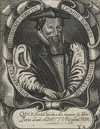 Robert
Abbot Robert
Abbot |
During these years the Rectors of Bingham included some fairly illustrious clergy. Robert Abbot became rector in 1598. He was the elder brother of George Abbot who was Archbishop of Canterbury from 1611 to 1633. Robert Abbot was appointed Master of Balliol College, Oxford in 1609. He retained his rectorship of Bingham, so may not have been resident in the parish for much of his time! In 1615 he became Bishop of Salisbury.
John Hanmer, who succeeded Robert Abbot in 1615, himself became a bishop. He was consecrated Bishop of St Asaph in 1624. He was also Prebendary of Worcester from 1614.
 Matthew
Wren Matthew
Wren |
A third successive future bishop succeeded John Hanmer. This was Matthew Wren, uncle of the famous Sir Christopher Wren, architect of St Paul’s Cathedral. Matthew Wren was appointed to the living of Bingham in 1624. He must have spent even less time in Bingham than his predecessors. He served as Master of Peterhouse, Cambridge, from 1625 to 1634. He was also during this time Prebendary of Winchester, Vice-Chancellor of Cambridge University and Dean of Windsor. He became Bishop of Hereford in 1634, Bishop of Norwich in 1635 and Bishop of Ely in 1638.
Of these three, John Hanmer was a man with puritan sympathies, as can be told from the books he encouraged. Matthew Wren, on the other hand, was a supporter of Archbishop Laud and the royalist cause and, as a result, from 1641 to 1659 he was imprisoned in the Tower of London.
It was not untypical for supporters of the two sides to rub cheek by jowl, and the religious issues could divide families. This was true of the Porter family in Bingham. One of that family, Samuel Porter, was a puritan and was Rector of Bingham from 1643. He, along with a number of other members of the family, was buried inside the church. (They were also local landowners.) Another member of the family, Henry Porter, disagreed with other members of his family on religious matters, and chose to be buried outside the church, so that the wall of the church itself would keep him apart from them.
In 1662, after the Restoration of the monarchy, Dr Samuel Brunsell was formally instituted as rector, a post he had in effect been fulfilling since 1648. Recent researches by C Davies have shown that this was probably a reward for services rendered. During the Civil War Samuel Brunsell had spent time in the Netherlands, and was closely involved with members of the exiled royal family. He served Katherine Stanhope, Countess of Chesterfield, who after her husband’s death took care of Princess Mary (daughter of King Charles I and child bride of Prince William of Orange). He came back to England in 1648 and somehow managed to convince the Parliamentary Commissioners that he was a suitable man to take up ministry in Bingham. During the following years, though, he acted as an undercover agent for the royalists – perhaps the 17th Century equivalent of a spy – as part of Lady Stanhope’s attempt to raise money to overthrow Cromwell and the Commonwealth. After the Restoration, Brunsell received several rewards of which the living of Bingham was one. (It was a rich living, then in the patronage of the Stanhopes.) He also held the livings of Screveton and of Upton at the same time, as well as canonries at both Southwell Minster and Lincoln Cathedral. There was a connection too with a former rector. Brunsell’s elder brother, Henry Brunsell was another royalist supporter who was well rewarded after the Restoration. Henry Brunsell married the sister of Sir Christopher Wren, and Matthew Wren was their uncle.
Brunsell is also known as one of the last men officially to ‘lay’ a ghost. Apparently this particular ghost walked because its body had not received a proper Christian burial. Dr Brunsell caused a coffin to be prepared and a grave dug. Cornelius Brown then relates:
This has been told to me by an old man whose grandmother heard it from her grandmother (all Bingham folk), that Dr. Brunsell, majestic in wig and gown, with the populace in procession, escorted that coffin, borne on bier shoulder high, from Chapel Lane to the churchyard, where the solemn burial service was read and the coffin lowered into the grave. Thenceforth that restless spirit troubled no more the good people of Bingham.
Samuel Brunsell was buried in the north transept of the church, and a finely engraved slate slab placed over his tomb. When the new platform was put into the church a trapdoor opening was left so that the stone could still be viewed. After his death in 1687 he was succeeded as Rector by his son, Henry Brunsell, who is also buried in the north transept and has a viewable tomb.
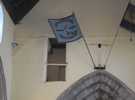 Part
of the original Part
of the originalroof line (inside the church since 1873) is visible near the corner |
Apart from the removal of decorative items and those seen as ‘popish’, there were few changes to the building during this period. The church was given a lower flat roof in 1584 (though it was later raised again). This made the interior of the nave dark and oppressive. The oldest of the church bells also dates from this era, traditionally said to have been cast to commemorate the English defeat of the Spanish Armada in 1588. This bell was made by Francis Wattes who was a native of Bingham and is said to have been buried in the churchyard. Another bell is surprisingly dated 1647, soon after Bingham life was disrupted by both the Civil War and an outbreak of the Plague, and a third was added after the Restoration in 1662.
The Eighteenth Century and Georgian Period, c1700 to c1810
Around the beginning of this period, or perhaps a little before, England underwent a revolution in both its economic life and physical appearance, when the large medieval open fields were ‘enclosed’ into the pattern of hedged fields which still survives in essence today. In the Bingham area this happened largely at the initiative of Philip Stanhope, Earl of Chesterfield, who was by far the largest local landowner, as well as being patron of Bingham Parish Church. The process modernized farming life, and incidentally produced a greater income for the parson in the form of ‘tithes’. Bingham was recognised as the richest parish in Nottinghamshire, based on the value of the tithes, ‘glebe land’ (which the rector farmed himself) and other income.
The 1700s were generally a period of religious apathy in the Church of England, and many parsons were only interested in the income they could glean from their parishes. Numerous churches fell into disrepair, and many people turned to the newly-emerging nonconformist groups such as the Methodists for spiritual fulfilment. The first Methodists were recorded in Bingham in the 1790s.
Bingham Church had only two rectors in nearly a century – from 1711 to 1810 – and both caused difficulties for different reasons. There was an initial burst of activity when the Rev Henry Stanhope (an illegitimate son of the Earl of Chesterfield) arrived in 1711. Above the chancel arch on the nave wall he erected a royal coat-of-arms in ornamental plasterwork which was later described in 1792 as ‘exceedingly elegant and esteemed a great amenity’. The arms (of Queen Anne) bore the date 1711 and were flanked by plaster cherubs. At the east end of the chancel the marble communion table was given a similar ornamental plaster reredos, incorporating the names of both the rector and his curate. (None of this work survives to the present day). Unfortunately soon after his arrival Henry Stanhope went mad and had to be confined for the rest of his long life, being declared ‘incapable of duty by means of a phrensy’; the services were provided by a succession of curates who were often priests serving at other churches as well as at Bingham. The results were not always felicitous. Throsby, while refusing to name the particular clergyman concerned, describes one occasion thus:
Suffice it to say that the jolly god, Bacchus, had so bountifully distributed his delicious draughts to the priest, that with much difficulty he read to the end of the Te Deum, “O Lord in thee have I trusted, let me never be confounded.” He then dropped on his breech, and slept his congregation out of doors. The boys of the town, sometime afterwards, on his leaving the church, saluted his ears with hoots and hisses into the fields.
 The Rectory built by The Rectory built byJohn Walter (photo dated 1904) |
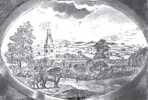 Throsby’s
sketch Throsby’s
sketchof the church |
From 1764 to 1810 the rector was the Rev John Walter, whose main interests appear to have been hunting and high living. He frequently resorted to the law over tithes and other matters of dispute with his parishioners. (He tried to revert to the practice of tithes being provided in kind, and would sit in the church porch for them to be delivered to him. The local farming community was less than delighted by this. Maybe some of the rector’s claims were valid that they had, for instance, watered the milk!) In 1770 he built a large new Rectory with a tithe barn to store the produce of his tithes. (The former parsonage house was a much more modest affair which stood in the (then) north-west corner of the churchyard. It was let out to tenants for a while, and was still standing in 1800, but was later destroyed. The Georgian Rectory was eventually pulled down in the 1960s, and the site used for the new school. Some cottages just south of the church were knocked together to make a new Rectory. This was never very satisfactory, and a new purpose-built Rectory was erected in 1990.)
In 1773, during the Rev John Walter’s incumbency, the chancel was ‘beautified’, probably by the erection of a ceiling to hide the roof, and new altar rails were added; these changes were however regarded by the 1840s as being ‘in barberous taste’! A new marble altar slab was brought from Bakewell in the Peak District in 1769. Writing in 1797 Throsby, making a sketch of the church, described it as ‘a neat, but not an elegant structure’.
John Walter does not seem to have got on well with his parishioners. Some of his actions appear to have been designed deliberately to annoy them, such as having four of them arrested for playing quoits in the Market Place. At other times the parishioners got their own back. An old custom was discovered of ringing the church bell in the very early morning to awaken the workers for work in the fields. The Rectory being so close to the church, the rector was the one who heard this bell most clearly!
Perhaps despite the rector, during this period church life remained vigorous and many parishioners were active performers of church music. A choir, or ‘society of singers’ was established by 1778 (which used to fine its members two pence for swearing in church), and there were also several fiddle players, and an enthusiastic group of bell-ringers, known as the ‘society of ringers’, who turned out to ring peals to celebrate national events such as the Battles of Trafalgar (1805) and Waterloo (1815). A number of people were members of both of these two societies. One such was Matthew Stewardson who died in 1780 and on whose gravestone in the churchyard it is inscribed:
This stone erected by the joint contributions of the Society of Singers and Ringers in this town to perpetuate his memory & also a manifest token of their concern for the loss of so valuable a member
Some events are known from this time which affected the church. On the morning of 21st September 1775 the spire was struck by a lightning bolt. The only deaths resulting from this were of 13 pigeons and 3 jackdaws, but eleven boys who were in the church were ‘thrown down with great violence’ and three of them were said to be ‘much scorched’. The bells were unharmed, but the clock was damaged, and some stones dislodged from the tower.
In December 1776 the church was broken into (perhaps a less common occurrence then than it is now). The thieves were not able to find much to steal, and made off with no more than some sacramental linen and gold lace from the pulpit.
It hardly ever happens that anyone answers the call in the banns of marriage that if anyone “know any cause or just impediment why these persons may not lawfully be joined together in holy matrimony, ye are to declare it.” It happened in Bingham, though, in 1791 when a young man seeking to be married was underage, and the marriage was forbidden by his father.
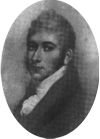 The
Rev The
RevRobert Lowe |
The Regency, Victorian and Edwardian Period, c1810 to c1935
In 1810 the Rev Robert Lowe was appointed Rector of Bingham. Robert Lowe had an influence on national government policy with his ideas for dealing with the problem of relief for the poor. His ideas formed a basis for the 1834 Poor Law Amendment Act (also known as the New Poor Law). A workhouse was established in Bingham in 1818, and then a new one in 1837. He is probably best known, though, as being the father of Robert Lowe, later Viscount Sherbrooke, an important figure in 19th Century British politics and who served as Chancellor of the Exchequer from 1868 to 1873 as part of William Gladstone’s government. Viscount Sherbrooke was born in Bingham Rectory.
A memorial to Robert Lowe (Snr.) is on the south wall of the chancel.
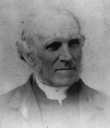 The
Rev The
RevRobert Miles |
Bingham church entered a new era in its history with the appointment as rector in 1845 of the Rev Robert Miles, a wealthy and forthright evangelical, son of a Member of Parliament, with a highly artistic family. In particular his youngest son, George Francis (Frank) Miles, who was born in 1852 became a fashionable London artist. Frank Miles also became a friend (and perhaps more) of Oscar Wilde who visited Bingham Rectory, and a friend also of Lillie Langtry (a celebrated beauty known as ‘the Jersey Lily’ and a close intimate of the Prince of Wales, later Edward VII). Lillie Langtry also visited the Rectory, and it is thought that she may have been a model for some of the figures painted in the church during Robert Miles’ time. (The figures in the angel painting and the Miles memorial window are the only ones surviving today that could be candidates.) Robert Miles’ wife, Mary, was also an artist, as was at least one of their daughters, and there was a cousin who was a musician and friend of Ralph Vaughan Williams.
Almost as soon as he arrived in Bingham, Robert Miles enlisted the services of Sir George Gilbert Scott, one of the foremost ‘gothic’ architects of his day, to restore the church and make other improvements. These were carried out in 1846. The changes involved removing almost of the alterations carried out in the previous century. The decorated plasterwork was all removed, and the chancel was altered, removing the ceiling, and probably adding the decorations that can still be seen on the beams. Much of the badly-eroded medieval window tracery was replaced. The current pews date from this era, as does the marble-tiled floor in the chancel which Robert Miles put in at his own expense.
Robert Miles also built the Bingham Church School at the same time. (The building is now called Church House and used as a church hall.) The first headmaster appointed for the school, in 1846, was Alfred Mowbray, a strong adherent of the Oxford Movement (ie the ‘High Church’ group in the Church of England). Mowbray, along with the Rev Nathaniel Keymer, the curate, had a significant influence on Miles, who became much more of an enthusiast for Anglo-Catholicism. In 1858 Mowbray left to found the well-known and influential religious bookshop in Oxford that still carries his name, though it has been a part of Hatchards since 2006. He is responsible for the design of one of the windows in Bingham Church.
Further restoration of the church was carried out under Miles’ direction in 1873, the architect this time being his artistic son Frank Miles, even though he was barely 21 years old. This included raising the nave roof. (The roof had been lowered in 1584 from its original height. The new roof is about 4 feet higher than the pre-1584 roof. The original roof line is visible on the interior west wall.) Three small clerestory windows were inserted on each side in the new upper sections of the walls.
The chancel screen was also redesigned at this time, and decorated by Frank Miles and by Robert Miles’ wife, Mary. Some of the carving in the church was undertaken by Eleanor, Robert and Mary Miles’ eldest daughter. This included some of the nave corbels, and carving on the oak reredos (which was later replaced by the current one).
Mary Miles was a not inconsiderable artist herself. In 1884 she executed a mural painting of a procession of angels playing musical instruments (depicting the 150th Psalm) as a frieze around the plastered walls of the church. (The frieze was removed in the early 1900s and most of it has been lost. A fragment of it was framed, and this was restored to the church some years ago and now hangs on the chancel wall.)
During Robert Miles’ time much stained glass was inserted in the church windows, and parts of the interior were painted with religious pictures, many executed by his artistic wife and children. These were frequently in the ‘Pre-Raphaelite’ style. The current clergy vestry was added to the church in 1863 to accommodate the organ; a new clock was installed in the tower in 1871, and the lychgate put in in 1881.
A plaque on the wall of the choir vestry acknowledges the work that was done on the church building in the time of Robert Miles.
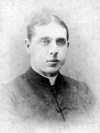 The
Rev The
RevPercy Droosten |
Miles’ successor in 1883 was the Rev Percy Droosten, formerly Vicar of Prittlewell (Southend on Sea). He was something of an English and Greek scholar. He translated The Confessions of St Augustine into English from the original Greek, and wrote a number of articles on church law and history. He introduced full High Church services into the church amidst some opposition from his parishioners.
Droosten was followed by Canon Henry Hutt, rector from 1910 to 1933, whose views were more centrally Anglican. He did much to change the interior of the church, removing many of the Miles’ paintings, and encouraging his parishioners to make numerous gifts of elaborate furnishings to beautify the building. He employed the architect W D Caröe to restore the church in 1912-13 and to design many of the new fittings. These included particularly the choir stalls in the chancel.
After the First World War the upper section of the chancel screen was removed and replaced by a new screen as a War Memorial (amid some opposition from non-conformists who objected to what they felt was presumption on the part of the Church of England rector).
A recognised character of Bingham at around this time, and a committed member of the church, was Miss Ann Harrison. After the First World War, when she was already a very old woman, she felt it was necessary to raise some money to purchase a Roll of Honour book, to contain the names of those who gave their lives in the war. This she did by collecting scraps from many local households, which she then sold as pig food. She gained a great deal of respect, and after her death in 1928 at the age of 98 years, the community had a wooden statuette of her carved and placed in the church. The Roll of Honour which she purchased is still in use, and the names are read from it on every Remembrance Sunday.
In 1922 the bells were all taken down and they were rehung with two extra bells added. Further remedial work was carried out on the tower and spire at the same time, including on the weathercock. (While the weathercock was on the ground children from the school were encouraged to jump over it, so that they could claim in later life that they had once jumped over the weathercock that was on top of the church spire!)
 Service booklet Service bookletproduced for the 700th anniversary |
In 1925 the church celebrated its 700th anniversary, with special services on All Saints’ Day, 1st November. (The church was still normally known as All Saints’ Church at this date.) To mark the anniversary a new altar was introduced into the church, with carved wooden cross and candlesticks. There also were two large candlestands and, most significantly, a large carved and gilded reredos was installed, incidentally hiding the lower half of the east window which had been designed by Mary Miles.
In 1926 the old Norman font was brought back into the church and restored. It was dedicated exactly one year (less a day) after the 700th anniversary service. Most of the money for this particular restoration was raised by the children of Bingham. After Canon Hutt’s death the baptistry was enclosed as a memorial to him, something he had wished to be done. The work was again by Caröe. The children once again contributed, this time by providing a figure of St Christopher placed on the west wall.
The Modern Period, c1935 to the Present
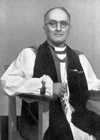 The
Rt Rev The
Rt RevMorris Gelsthorpe |
For a time in the mid 20th Century Bingham received the ministry of two Bishops. The Rt Rev Morris Gelsthorpe was instituted as Rector of Bingham in 1953. As a young man Morris Gelsthorpe had served as curate in Sunderland under the vicar, the Rev Bertram Lasbrey. The two men became firm lifelong friends. Lasbrey was appointed Bishop of Niger in 1922, and soon afterwards he invited Gelsthorpe to join him in ministry in Africa. Gelsthorpe became assistant bishop in Niger in 1932, later moving to serve in Sudan and becoming first Bishop of Sudan when it was constituted as a separate diocese in 1945.
When Morris Gelsthorpe returned to England as Rector of Bingham, Lasbrey (now retired) came to join him and lived at Bingham Rectory. It was said that Bingham had not only a bishop as its rector, but a bishop as its curate too! In reality, of course, they both served as assistant bishops in Southwell Diocese. A monument to them both is on the north wall of the nave.
Bishop Gelsthorpe established a side chapel in the south transept, and in 1957 it was dedicated by the Dean of Lincoln. This restored an old use of the transept. It had been the chapel of the Guild of St Mary in the 15th and early 16th Centuries. (The oak altar and reredos are still in place. The altar rails from that chapel are now used in the nave with the same altar brought to the middle.) The oak west screen, including the door to the tower, was erected at the same time. The woodwork for this was all provided by Robert Thompson, the ‘mouseman’ of Kilburn.
dated 1975 |
Another important anniversary, the 750th, came up in 1975, during the time of the Rev David Keene. As had happened 50 years before, there were celebratory services. As a mark of the celebrations the clock was electrified so that it no longer had to be wound laboriously by hand. A cut-away drawing of the tower showing the operation of the bells was made at the same time.
The arch above the fairly new west screen was filled in with glass in 1972. New lighting was installed in 1979.
In 1988, during the time of the Rev David Swain, the church entered a Covenant for Unity with Bingham Methodist Church and the local Roman Catholic parish (St Anne’s, based at Radcliffe-on-Trent.) Commitment to working together has been a powerful feature of church life in Bingham since then.
In 1992 a platform was built across the front of the nave and incorporating both transepts. This has had a major effect on the building, allowing services to be conducted with an altar much nearer to the people than before. A sound support system was installed at around the same time.
 The
hanging The
hangingcross |
Also in 1992 the Hanging Cross was put in place. This was given as a War Memorial to those who gave their lives in the Second World War. The idea was initiated by the Bingham Branch of the Royal British Legion. A few years later, in 1996, the laid-up banners of the British Legion and RAF Association were mounted on a bracket on the west wall.
After several years of gradual deterioration, the pipe organ finally gave up the ghost in 1997. It was replaced by a modern electronic organ. A spin-off from this was that it released the space the pipe organ had formerly occupied, allowing for a considerable enlargement of the clergy vestry.
In 1998 the floor of the bell-ringing room started to show signs of weakness. It was noticed that the beams supporting this floor had been cut short to accommodate the clock weights, presumably when the clock was installed, but they had not been reinstated when it had been electrified. The floor had to be strengthened for safety of the ringers.
The lychgate that Robert Miles had installed was starting to lean to one side, and showing other signs of deterioration. It was restored in 2000 as a Millennium Project by the Friends of Bingham Parish Church.
In 2007 toilet facilities were put in the church in the base of the tower. A couple of memorials that would otherwise have been obscured were resited in the body of the church. At the same time a tea-point was built at the west end of the north aisle. These were designed by Allan Joyce, architect, and the design of the tea-point aims to reflect, in a more modern idiom, the Caröe woodwork around the baptistry on the south side.
In the early morning of 27th February 2008 a minor earthquake shook the East Midlands. There was little damage in Bingham, but the finial cross was shaken off the east end of the chancel of St Mary and All Saints’ Church and shattered. It has now been replaced.
One remaining question is when the Church, which was known as “All Saints’ Church” since its foundation in the 13th Century, became known as “St Mary and All Saints’”. The words “St Mary” were added to the original name of the church in acknowledgement of the Guild of St Mary, which had formed a part of the life of the church and community in the Middle Ages. It is not clear, though, who had the idea of adding it, and it seems to have taken a while to catch on. The plaque on the vestry wall which recognises Robert Miles’ work probably dates from soon after that work was completed in 1873. This names the church as “St Mary and All Saints’”. However the church continued to be referred to as “All Saints’ Church” through the rest of the 19th Century, and well into the 20th, just occasionally being referred to by the longer name. The new name began to take hold around 1950, and has now become the name by which the church is most commonly known, frequently now being shortened to merely “St Mary’s”.
In recent times the church has been working closely with the surrounding community. Perhaps the most notable sign of this has been the Christmas Tree Festivals, begun in 2006.







